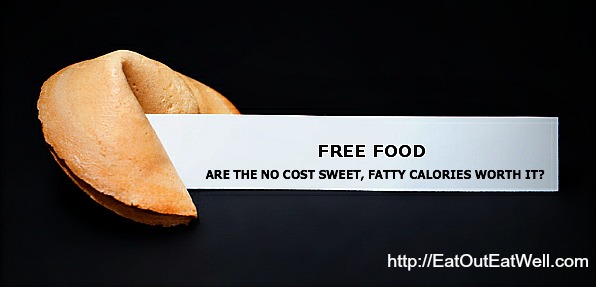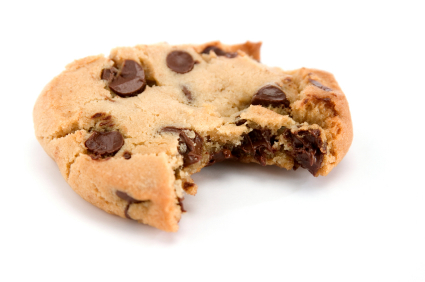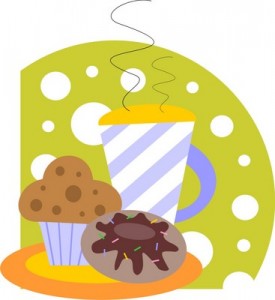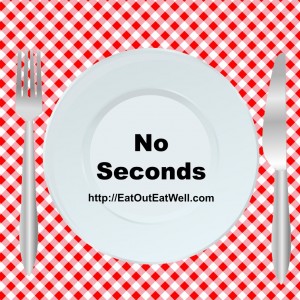 You have an early morning meeting. Sitting in front of you is a platter loaded with bagels, danish, and doughnuts just waiting to be eaten and washed down by copious amounts of coffee.
You have an early morning meeting. Sitting in front of you is a platter loaded with bagels, danish, and doughnuts just waiting to be eaten and washed down by copious amounts of coffee.
If you didn’t have time to grab some and if all the platters aren’t picked clean, the remnants will surely end up in the snack room next to the birthday cake (it’s always somebody’s birthday) or the leftover cookies from someone’s party the night before.
Perhaps you shop at Costco on the weekend. At least three tables will be manned by someone offering you samples of hot pizza, luscious cheesecake, or tooth-picked pigs ‘n blankets just waiting to be quickly and neatly popped into your mouth.
Maybe you then make a stop at the cleaners, the tailors, or the veterinarian. There it is – the giant bowl piled high with freebie candy. You can dig deep for the kind you like – Reese’s Peanut Butter cups, mini Snickers, or Tootsie Roll pops. You name it — it’s usually there for the taking.
Going to a wedding that night? How do you escape the platters of salami, cheese, mini quiches, and then the desserts covered with icing and whipped cream?
What’s The Problem With Easily Accessible Free Food?
Not a thing if you don’t care about calories, nutrition, and how you’re going to feel after an overload of sugar, fat, and salt. It’s also very attractive if you don’t have a lot of money to spend and your belly is screaming, “I’m hungry.”
Occasional dips into free food probably aren’t going to hurt anyone in reasonable health. But, consistently finding your hand in the candy or goldfish bowl or on the sample tray in Costco has a caloric downside. And, non-nutritious junk, processed, and high calorie food negatively impacts your concentration, alertness, and energy. Your simple carb freebies will send your blood sugar on highs and lows worthy of a roller coaster ride.
Easy To Understand – Hard To Do
It’s one thing to understand all of that. The problem is that most of us find it pretty darn hard to ignore the food that’s just there for the taking. It’s everywhere – and we value cheap calories. When was the last time that you resisted the peanuts, pretzels, or popcorn sitting on the bar counter? What about the breadbasket – that’s usually free, too.
We don’t have to eat any of this stuff. But we do. Why? Some of us have trouble passing up a giveaway; some of us see it as a way to save money, even with possible negative health consequences; and some of us use “free” as an excuse to eat or overeat junk food or the sweet, salty, fatty foods that some call addicting.
And the calories? Just because it’s free doesn’t mean the calories are, too. It’s all too easy to forget about those calories you popped in your mouth as you snagged a candy here and tasted a cookie there.
Things To Think About Before The Freebies Land In Your Mouth
You might want to come up with your own mental checklist that, with practice, will help you decide if it’s worth it to indulge. If you decide to taste the salami and have a cookie and a piece of cake, at least you’ll have made a conscious choice. Ask yourself:
- Is the food fresh and tasty? It might be if you’re at a catered wedding or a private party, it’s more questionable if it’s being handed out at the supermarket or sitting in a large bowl at the cleaners.
- Is it clean? How many fingers have been in the bowl of peanuts on the bar counter or have grabbed pieces of cheese or bunches of cookies off of an open platter?
- Do you really want it – or are you eating it just because it’s there?
- Is it loaded with fat, sugar, and salt that add up to mega calories? Every calorie counts whether it’s popped in your mouth and gone in the blink of an eye or savored more slowly and eaten with utensils off of a plate.
- If you fill up with the non-nutritious free food, are you skimping on the nutritious stuff later on because you’re simply too full to eat it?
- If you start nibbling on the free food, does it open the flood gates so that you continue to indulge? Loading up on simple sugars – like those in candy, cookies, cake, and many processed foods – causes your blood sugar level to spike and then to drop – leaving you hungry and pretty darn cranky.
You Do Have Choices
- You don’t have to eat food because it’s free. No one is forcing you to make some more room on the serving tray or breadbasket by sampling one (or more) of each variety.
- If you sample the candy, pizza, cheesecake, popcorn, or pieces of cookie, are you giving yourself permission (perhaps in disguise) to overindulge in food you might not ordinarily eat?
- Be aware of the cascade. Sometimes you can’t eat just one – it’s more like eat one and you can’t stop.
- If you know you’re going to be tempted, plan to indulge. Do it mindfully, not mindlessly: build it in. Eat a lighter lunch and don’t go shopping or to an event when you’re starving — a sure ticket to chowing down on almost everything in sight.
- Have your own personal policy for bowl dipping – the quick hand dips into the candy bowl at the receptionist’s desk, the jelly beans on your friend’s table, the chocolates on the counter. Aside from the calories think about all of the other hands – and where those hands have been – that are also dipping into the same bowl.
This article is part of the 30 day series of blog posts called: 30 Easy Tips for Looser Pants and Excellent Energy.



